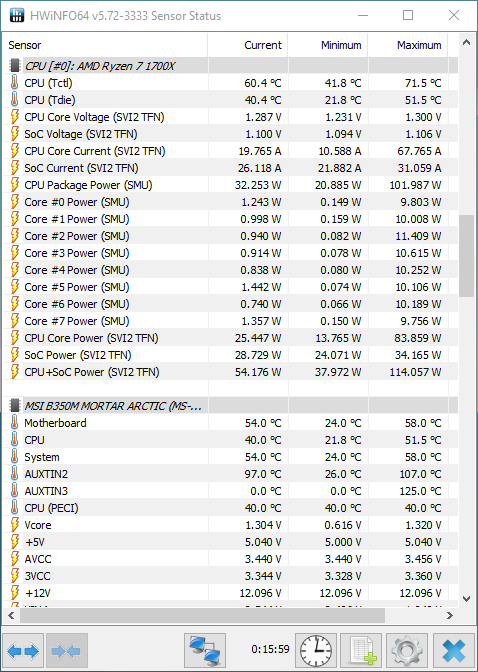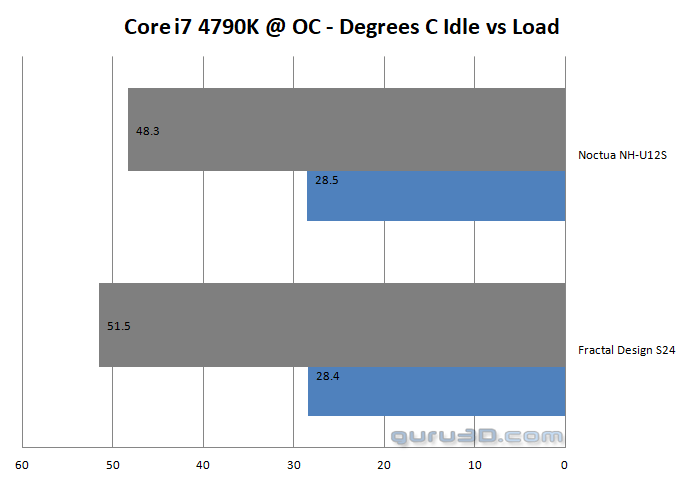Adding some juice
Adding some juice...
As said before, the overclocked run will still use WPrime as the stresser of choice. This time, however, the all-core clock will be boosted to 3.8Ghz, and voltage upped to 1.315v on the VCore. SOC voltage (in order to keep my memory happy) is also higher than normal, at 1.15v as opposed to the default of just 1.1v, as this does affect package temperatures. All of this will put a higher strain on the cooler than before, and it will be interesting to see how it compares to my regular NH-U12S.
Right off the bat, the potentially 'odd' result of the stock run continues here. The S24 reached a max package temp of 51.1C with the overclocked chip. The Noctua, a smaller air-cooled unit, performed better, reaching just 48.3C. How is this possible? Before I get onto revealing why, Both results do lend credence to Ryzen being a fairly 'cool' platform, as well as being power efficient. The AIO, moving parts are larger size aside, has, ultimately, the medium of water as a means to conduct heat away from the CPU. So, why does the smaller Noctua unit perform better?
Well, it's been mentioned a couple of times here already, and it is also echoed in reviews of this unit on other tech publications. Noise. This cooler is, effectively, damn near silent. The Noctua unit put in a good showing, to be fair, getting to 39Dba in the overclocked test. Remember, however, that an increase in decibels is actually a non-linear scale. A single decibel might be 'perceived' by the average person, but 3 decibels is actually perceived by most as being around 2x as loud. So, when you consider that the Fractal unit came in at just 34 decibels when overclocked, you can begin to appreciate Fractal Design's hard work toward making this unit truly silent. Sure, you could drop the temps by switching to PWM mode and ramping the fans up (they're fairly quiet anyway), but for the sake of 3 degrees, I would rather have a unit that was nearly four times as quiet, i.e. 34Dba to 39(ish) DBa. That, you have to say, is impressive work and design from Fractal, without a doubt. Some may wonder why we have chosen WPrime as our stress of choice, rather than a more heat-intensive test such as Prime95's Small FFTs or OCCT's Large Data Set. Whilst these would have provided a more intensive test for our two coolers, we feel as though 3 consecutive runs of WPrime is a little more realistic. You also cannot call 51.1C 'bad,' by any stretch of the imagination, and if silence is your game then the S24 has put in a truly excellent showing today.
Note: we have very few results as this article is made by an overseas editor, on a Ryzen platform. Over time these results will build up with more coolers, of course.
If we were to give the S24 a 'rating' based on how it performed in the OC test (I would argue it's the only one that actually matters, given the use case for these coolers is to overclock), we would award it with 'Performance' cooling status. Yes, it gets outperformed by a 120mm air cooler. However, this is not much of a surprise. Whilst water as a medium of heat transfer is better, and the S24 has (effectively) double the heatsink space to dissipate heat with, fan speed ultimately counts for a lot in terms of 'pushing away' the heat. On the S24, all of this leads to fans that can spin at a much slower speed. This would mean little, of course, if the fans were poorly designed, but I genuinely like these GP-12's and think they also 'look' the part. Double whammy. However, simple physics can explain only so much. The fact is that Fractal Design has, I would argue, designed a truly excellent cooler with each element being geared toward a certain audience. There is also another factor that is undoubtedly at play here, and - for that - see below.
Believe it or not, radiator placement as intake or exhaust does actually have an effect (sometimes notably so) on CPU operating temperatures. Why? Well, if used as front/top intake, the air flowing over the radiator is 'fresh', and will not have been warmed up prior by internal system components like your GPU (especially if your card is a traditional 'open face' style design). AIOs used as exhaust will have air flowing over the radiator that is already a little warmer than the air on the outside of the case. Bear this in mind, as the 3(ish) degree delta we saw between the NH-U12S and S24 may well have been down to that.
With all that out of the way, shall we head on over to the conclusion of this review?



